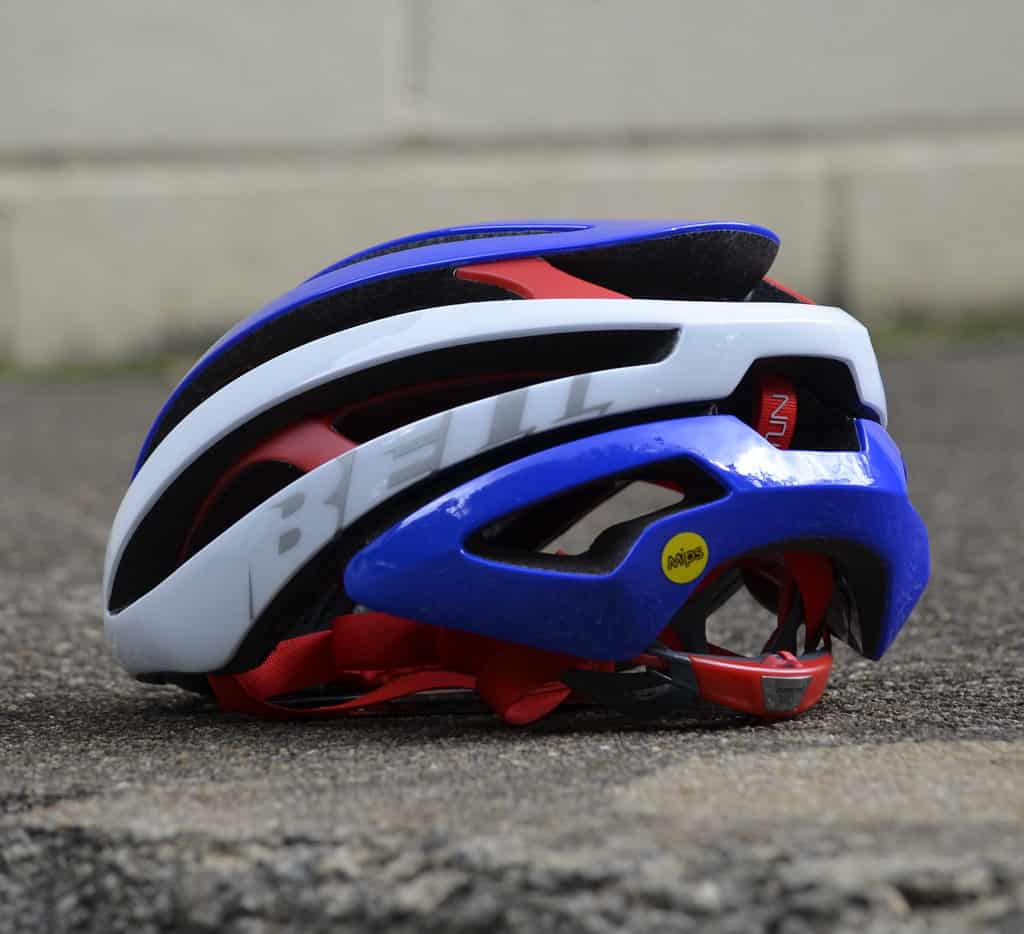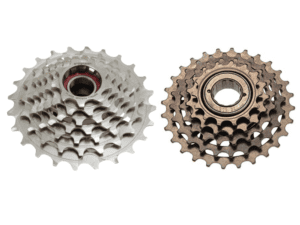You are probably choosing a new bike helmet and can’t decide whether to go with a MIPS or Non-MIPS helmet, right? Well, you are in the right place.
While there’s no concise answer to settle this debate, we can say that. “Helmets with MIPS technologies can reduce the impact of rotational forces. Due to this fact, they can keep the head and skull away from instant impact, shock, and concussions.”
That said, we are here today to get into the details of this MIPS technology, how it works, and from where it originated.
Not only that, but we will also consider some recent research and studies about the effectiveness of MIPS in bike helmets.
Let’s jump straight to it.
Settling the Debate of MIPS vs Non-MIPS Bike Helmets
What is MIPS?
MIPS stands for “Multi-directional Impact Protection System”. Helmets that use this technology are called MIPS-infused or simply MIPS bike helmets.
If you take a look at the inner side of your bike helmet, you will see an extra yellow lining just below the actual EPS foam padding.
This is where this protection technology gets installed and it works to reduce the impact of rotational forces to keep a biker’s brain and head safe from injuries, etc.
What does MIPS Do for Helmet?
The multidirectional impact protection system is based on slip-plane technology. To explain this technology, we first need to know how a biker falls casually from a cycle.
Simply put, when a rider falls off a bike, it’s not like his head will fall vertically on the road.
There would be some sort of forwarding force working and that’s the main reason one cannot say that the head is in a vertical angle when it touches the ground.
This is where we explain slip-plane technology. Slip-plane is actually the polycarbonate yellow layer sitting between the liner and the rider’s head.
Whenever there is a serious crash, the slip-plane technology allows the helmet to move for about 10 to 15 milliseconds upon oblique impacts.
This process reduces the impact of rotational energy on the head, thus keeping it safe from a serious rotational injury or concussion.
As soon as this helmet technology got introduced, it was meant for bike helmets only. But with time, the company has given the license to use it in other snow sports including ice hockey and snow skiing.
Where Did It Come From?
MIPS is all but a contribution from a Swedish Neurosurgeon, i.e. “Hans von Holst” who was studying why there were so many brain injuries even when bikers were wearing helmets.
A breakthrough happened in his research when he understood that the companies mostly focus on reducing the vertical impact while ignoring rotational forces.
He, then along with his colleagues Peter Halldin and Sven Kleiven at the Royal Institute of Technology, Stockholm decided to work on what we now call MIPS slip-plane technology.
They tested thousands of helmets but in a way when a rider really faces a serious crash. That said, the technology was a big success back in 2007 and it got officially infused into bike helmets in 2010.
How Much Safer is a MIPS Helmet?
This question, right here, has no straightforward answer. We simply cannot sum it up with either a YES or a NO.
However, we can take help from certain research studies to prove that MIPS can reduce the impact of rotational forces compared to a non-MIPS cycling helmet.
Research Study 1:
Done by NCBI (National Center of Biotechnology Information) in collaboration with PMS, the study tested five types of bike helmets that included MIPS, SPIN, non-MIPS, Omni-Direction Suspension, and Low-Layer Density helmets.
After a series of falls and tests at an angle of 45°, the study concluded that MIPS technology was able to reduce serious brain damage and injury by about 42%.
SPIN, on the other hand, performed even better and it was able to increase the protection by about 54%.
Research Study 2:
Another research study to see whether new bike helmet technologies are effective against serious crashes or not was done by the NCBI.
The study involved many types of helmets both conventional as well as the ones with protection technologies like MIPS, SPIN, and WaveCel.
It concluded with the result that, “Those helmets with some kind of protection technologies were more effective in reducing the rotational impact compared to other standard helmets.”
Takeaways:
Both studies mentioned above suggest that new protection technologies actually are reducing the impact of serious crashes.
From these studies, we could also assume that compared to non-MIPS helmets, the ones with MIPS technology will have a better chance of saving a biker’s head from traumatic injuries.
However, you need to keep in mind that MIPS itself is not a certification standard. It’s a company that offers slip-plane technology licenses to other bike helmets only.
Simply put, don’t rely on MIPS all the time. Check other certifications as well before you blow the final whistle on getting a MIPS-Equipped helmet.
What is the Benefit of MIPS?
Mountain bike helmets that come with a multidirectional impact protection system offer the following benefits:
Better Safety
It’s a no-brainer that helmets infused with MIPS offer improved safety and protection compared to regular non-MIPS helmets.
The research studies we mentioned above also suggest the same thing. MIPS Company, on the other hand, claims that it can reduce the rotational force impact by about 10%.
Keeping these factors in mind, one thing is adamant that a MIPS bike helmet ensures safety with the reduction of rotational forces.
Your head will remain protected from concussions, instant impact, and other traumas if wear your MIPS bike helmet correctly.
Simple Design
A MIPS helmet looks just like a regular helmet. That is, the protection technology is infused just below the EPS lining of a helmet and it looks the same as that of other standard helmets.
Simplicity intact, helmets with MIPS will keep protecting your head and skull from serious injuries.
Ventilation:
There won’t be any impact on the ventilation when you get a helmet infused with MIPS technology.
Ventilation is more of a concern when you are choosing either a full-face or an open-face helmet. MIPS has got nothing to do with it.
Multiple Choices Available
MIPS does not sell helmets as a company. It only gives licenses to companies like Bell, Smith, Giro, and Bontrager to make helmets infused with this protection feature.
So, you’ll have a plethora of helmet options to choose from this way.
Weight:
There’s no extra weight when you wear a non-MIPS and then a helmet with MIPS technology.
Cost:
Not too costly, a good MIPS helmet will cost you around $100 and even lower than that if you consider other brands and options.
Is a MIPS Helmet Necessary?
Although technologies like MIPS and SPIN have proven to reduce brain injury incidents in different accidents, we cannot answer whether a MIPS helmet is necessary or not.
You can use a regular non-MIPS helmet and it can keep you safe from multiple crashes and injuries.
The addition of MIPS, on the other hand, would give you an advantage, especially when you are a hardcore cyclist cruising downhill with a speed of 10-15mph.
So, although it’s not a necessity to get a MIPS helmet at all costs, we suggest you consider it for extra protection and safety.
Bikers Also Ask:
Are MIPS helmets heavier and bigger?
Helmets infused with MIPS are not much heavier or bigger than regular non-MIPS helmets, but the difference is not too much. Weight and size have more to do with full-face and open-face helmets rather than MIPS technology.
Do Arai helmets have MIPS?
Arai, being one of the most popular motorcycle helmet companies in the world does not use MIPS technology in the models it produces.
How often should a bicycle helmet be replaced?
You should replace your bicycle helmets when one of the following situations occur:
A Serious Crash—Get it replaced as soon as possible.
If the helmet is too old—Replace it with a new bike helmet.
If the helmet is doing well—The official CPSC, ASTM, and Snell guidelines suggest that you get it replaced after 5 years.
Do motorcycle helmets have MIPS?
MIPS got incorporated into bike helmets like a wildfire. However, to motorcycles, it’s still a new thing and now many companies are thinking about adding this protection technology to motorbike helmets as well.
Are MIPS helmets comfortable?
Comfort and relaxation depend on finding the right size as well as the right fit. This is why it is important to refer to a bike helmet sizing chart beforehand.
Moreover, it also depends upon the inner lining and whether it’s properly padded or not. MIPS certainly has nothing to do with making a helmet comfy or uncomfortable.
Final Takeaways: Is MIPS Worth It?
With the kind of research done on this new protection technology, one thing is clear MIPS helmets are effective in reducing the impact of rotational forces.
However, that doesn’t mean you should stop riding your bicycle carefully and drive it the way you want.
MIPS gives you an edge over non-MIPS helmets in terms of safety and protection, and in that context, it’s worth trying it, especially if you are a hardcore mountain biker.
Happy Cycling!





